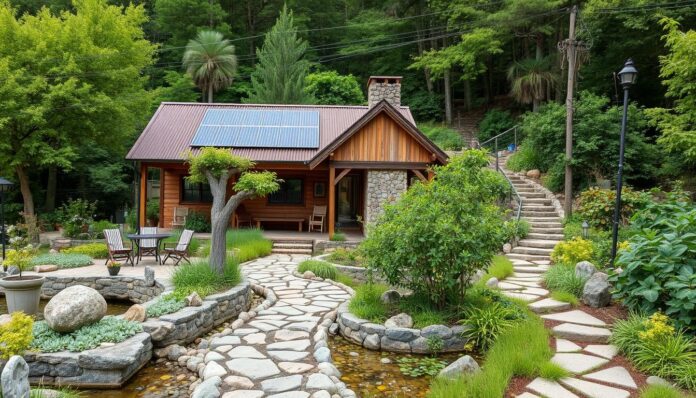Imagine a future where tourism meets permaculture hospitality. This blend of sustainable tourism and eco-friendly stays offers a special experience. The permaculture idea, started in the 1970s by David Holmgren and Bill Mollison, is now popular in rural tourism. It’s becoming a top choice for those wanting a real, green experience.
Permaculture hospitality is all about blending landscapes and people for a sustainable stay. It aims to provide food, shelter, and energy in a green way. By using permaculture, hotels and lodges can lower their carbon footprint and save resources. This supports the growth of green tourism and eco-friendly places to stay.
Key Takeaways
- Permaculture hospitality is a holistic approach to sustainable accommodation design
- Sustainable tourism and eco-friendly accommodations are becoming increasingly popular
- Permaculture principles can help reduce carbon footprint and conserve resources
- Permaculture hospitality promotes sustainable tourism practices and contributes to the growth of eco-friendly accommodations
- Rural tourism is shifting towards more sustainable and authentic experiences, with permaculture hospitality at the forefront
- Permaculture hospitality offers a unique experience for guests, combining sustainable tourism and eco-friendly accommodations
Introduction to Permaculture Accommodation Design
Permaculture accommodation design focuses on creating eco-friendly places to stay. It encourages regenerative living and nature-inspired design. This approach helps reduce tourism’s environmental impact while offering guests unforgettable experiences.
Sustainable design is key in permaculture accommodations. It cuts down on carbon emissions and supports green hospitality. Important permaculture design principles include:
- Reducing resource consumption and waste
- Promoting biodiversity and ecological resilience
- Using natural and renewable resources
Since the 1970s, permaculture design has grown in popularity. It has sparked more interest and formed regional groups. This approach can greatly reduce water use, pollution, and climate change effects.
Permaculture accommodations offer a unique, green stay. They support environmental care and social responsibility. This makes them a great choice for those wanting to live sustainably.
| Permaculture Principle | Description |
|---|---|
| Zone 0/00 | Core area where the designer works daily |
| Zone 1 | Area closest to the house, requiring daily or almost daily care |
| Zone 2 | Orchards and elements like compost bins, needing less frequent maintenance |
Principles of Permaculture in Design
Permaculture design principles are key for making systems sustainable and regenerative, especially in eco retreats. These principles follow a set of ethics that focus on caring for the earth, people, and fair sharing. By using these principles, eco retreats can lessen their environmental footprint and offer unique experiences to guests.
The design process in permaculture involves understanding the environment, using natural resources, and encouraging biodiversity. This approach makes eco retreats more resilient and sustainable. It benefits both the environment and the guests. Important permaculture principles include observing nature, catching and storing energy, and getting a yield.
By adopting permaculture design principles, eco retreats can positively impact the environment and support a sustainable future. This method also improves the guest experience, offering a deep connection with nature. As more people seek sustainable tourism, using permaculture in eco retreats is becoming crucial.
Some main advantages of permaculture in eco retreats are:
- Less environmental harm
- More resilience and sustainability
- Better guest experience
- More biodiversity
Site Selection for Permaculture Accommodation
Choosing the right site is key for eco-friendly accommodations. It should have a low environmental impact and offer a unique guest experience.
It’s important to check the land’s soil, topography, and biodiversity. Climate and microclimate also play a big role in design and operation. Legal and zoning regulations must be followed to avoid legal issues.
When picking a site, consider a few things:
- Access to natural resources like water and sunlight
- Being close to local communities and transport
- Availability of green building materials and energy sources
By looking at these factors, you can make eco-friendly places. These places support sustainable tourism and give guests a special experience. 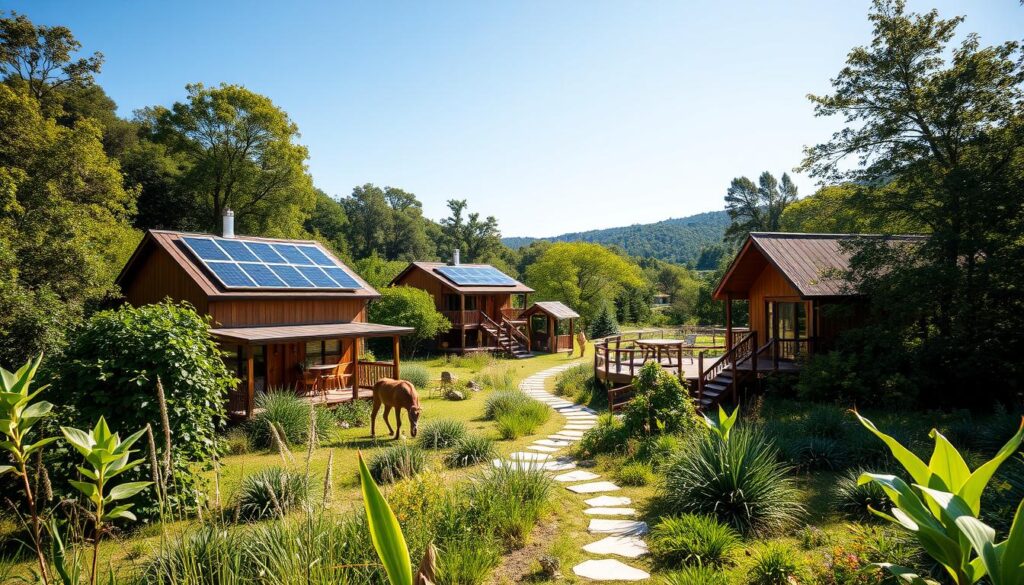
| Factor | Importance |
|---|---|
| Land characteristics | High |
| Climate and microclimate | High |
| Legal and zoning regulations | Medium |
Sustainable Construction Materials
Choosing the right materials is key to making eco-friendly accommodations. Green hospitality means using materials that are good for the planet and locally sourced. This helps reduce the business’s carbon footprint and supports sustainable travel experiences for guests.
Materials like locally sourced wood, adobe clay, bamboo, and straw are great choices. They add a natural look and help keep the place warm without needing synthetic stuff. Plus, they’re safe and healthy for everyone.
Here are some benefits of using sustainable construction materials:
- Reduced carbon footprint
- Promotes sustainable travel experiences
- Creates a natural aesthetic
- Provides excellent insulation
- Ensures a healthy and safe environment for guests
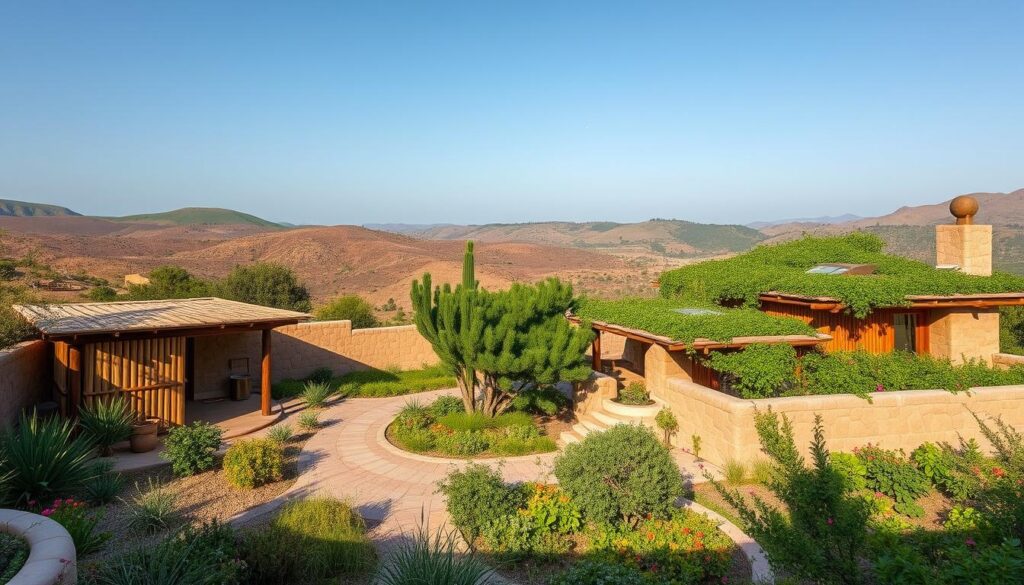
Using sustainable materials helps permaculture accommodations be kinder to the planet. It also benefits the local community by using local materials and supporting the local economy.
| Material | Benefits |
|---|---|
| Locally sourced wood | Reduces carbon footprint, promotes sustainable travel experiences |
| Adobe clay | Provides excellent insulation, creates a natural aesthetic |
| Bamboo | Renewable resource, provides excellent insulation |
Water Management Strategies
Effective water management is key for permaculture hospitality and eco-friendly stays. In places like the central southern United States, it’s vital to cut down water use. Rainwater harvesting systems help collect and store rainwater for uses like watering plants and flushing toilets.
Some important water management strategies for permaculture hospitality include:
- Rainwater harvesting systems
- Greywater recycling techniques
- Efficient irrigation practices
These methods help lower the water use of eco-friendly places. They also support sustainable tourism.
By using these strategies, permaculture hospitality spots can lessen their environmental effect. They can also offer guests unique and memorable stays. For instance, a permaculture hospitality spot can create a stunning, sustainable garden. This garden can be made with rainwater and greywater systems. It can also teach guests about sustainability.
| Water Management Strategy | Benefits |
|---|---|
| Rainwater Harvesting | Reduces water consumption, promotes conservation |
| Greywater Recycling | Conserves water, reduces wastewater generation |
| Efficient Irrigation | Optimizes water use, reduces evaporation |
Energy Efficiency in Permaculture Tourism
Energy efficiency is key in sustainable tourism. It helps lower the environmental impact of places where people stay. Permaculture tourism spots can cut down their carbon footprint by using energy wisely. For example, LINDENBERG hotel has gardens and GreenSign certification to lessen its environmental harm.
Hotels can use solar panels and energy-saving lights to be more efficient. Valle Escondido hotel uses solar for hot water and has lights that save energy. It also lets in natural light, cutting down on artificial light use.
Other ways to save energy include using green cleaning products and managing water better. These steps help reduce harm to the environment. They also make guests’ stays memorable, promoting sustainable tourism and living.
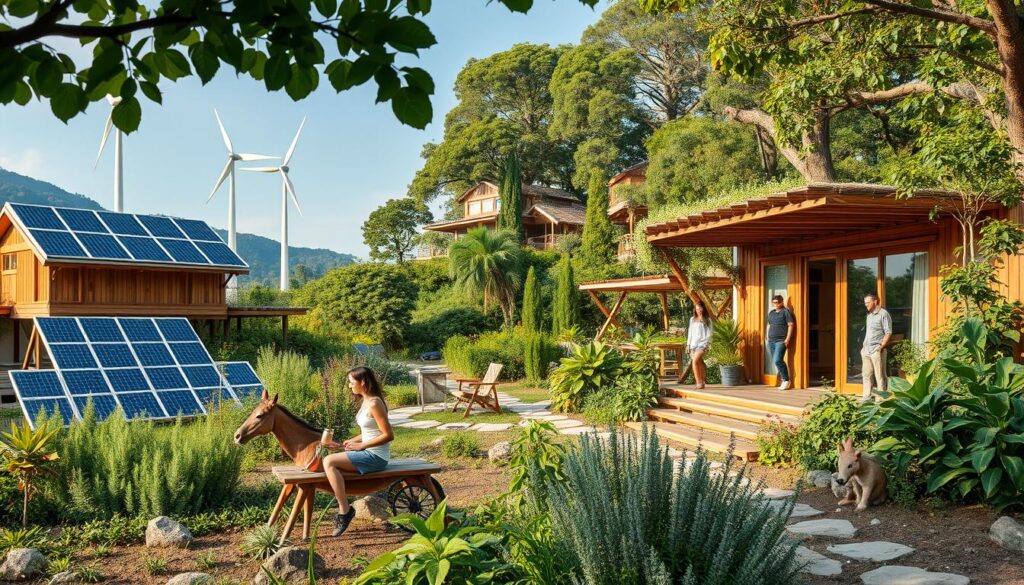
By focusing on energy efficiency, permaculture tourism spots help the planet. They meet the needs of travelers who care about the environment. As more people look for eco-friendly places, these spots are ready to serve them.
Landscaping and Biodiversity
Nature-inspired lodging goes beyond just reducing harm. It’s about making natural ecosystems better. Hotels like Room + Wild Hotels show this by boosting biodiversity and ecosystem services. They do this through native plant gardens and permaculture design for wildlife.
Places like Bambu Indah and Fazenda Moreias are great examples. Bambu Indah has nine bamboo structures, and Fazenda Moreias runs on solar panels and lithium batteries. These hotels show how green hospitality can help the environment and support local life.
Key benefits of nature-inspired lodging and green hospitality include:
- Promoting biodiversity and ecosystem services
- Reducing environmental impact
- Providing a unique and memorable experience for guests
- Supporting local economies and communities
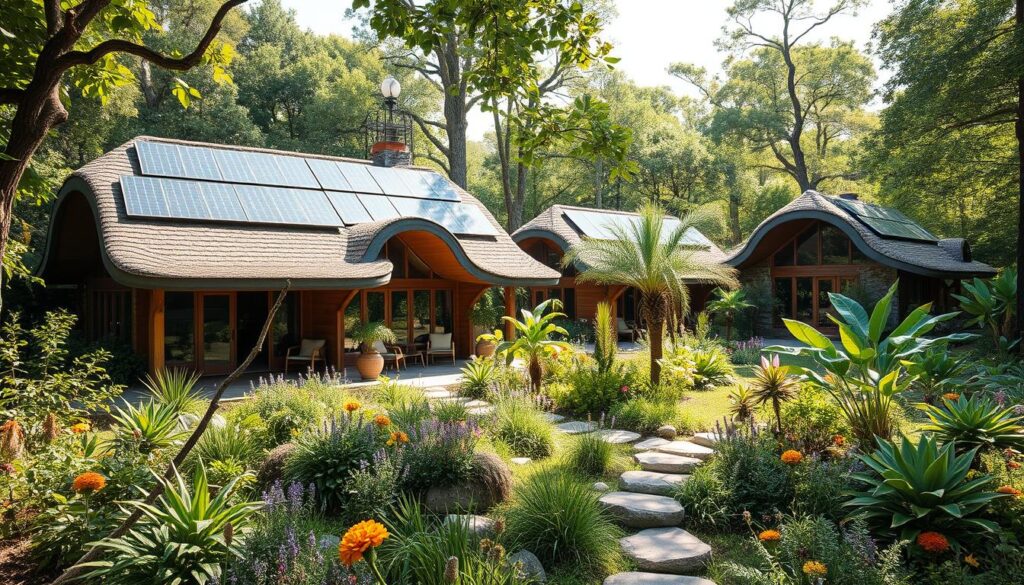
Hotels that focus on nature and green hospitality help make tourism more sustainable. As more people look for eco-friendly travel, hotels that care about the environment will attract them.
| Hotel | Location | Green Hospitality Features |
|---|---|---|
| Bambu Indah | Bali, Indonesia | Locally sourced bamboo, reclaimed teak, and open-air spaces |
| Fazenda Moreias | Brazil | Off-grid energy, solar panels, and lithium batteries |
| Oasyhotel | Tuscany, Italy | Integration with natural surroundings, preserving biodiversity |
Designing for Guest Experience
Designing for guest experience is key in permaculture hospitality. By using natural aesthetics and eco-friendly amenities, guests have a unique and memorable stay. About 73% of travelers choose places that are green, showing the importance of sustainable travel.
Features like natural materials and outdoor spaces help guests feel well and connected to nature. For instance, hotels with solar panels save over $1,500 on energy and make about $16,000 from green energy credits. Rainwater harvesting cuts water use by 30%, and gray water recycling can save up to 40%.
Guests can also join in on educational activities like workshops and tours. These teach about permaculture and sustainable living. For example, learning about permaculture animal welfare and how to live sustainably.
- Permaculture design workshops
- Sustainable gardening classes
- Nature walks and wildlife tours
Permaculture hospitality offers unique and memorable experiences. It promotes sustainability and eco-friendliness. As more people seek green travel, permaculture hospitality is ready to provide enriching experiences.
| Feature | Benefit |
|---|---|
| Natural materials | Promotes sense of well-being and connection to nature |
| Outdoor spaces | Encourages physical activity and mental health |
| Sustainable amenities | Reduces environmental impact and promotes eco-friendliness |
Community Engagement in Design
Community engagement is key in making eco-friendly places. Working with local people helps in being culturally sensitive and supports local businesses. This way, places can lessen their environmental harm and offer guests special experiences. It’s crucial for sustainable tourism as it makes places part of the community.
Examples of community involvement include using local materials and hiring local workers. Creating community gardens and green spaces is also important. These actions support regenerative living and offer chances for learning and cultural sharing. By doing this, eco-friendly places can lower their environmental impact and help the local community.
- Collaboration with local stakeholders
- Support for local economies
- Cultural sensitivity in design choices
By focusing on these points, eco-friendly places can positively affect the local community. They promote sustainable tourism and regenerative living.
Challenges and Solutions in Permaculture Accommodation
Starting a permaculture hospitality and eco-friendly accommodations can be rewarding. But, it also comes with challenges. One big issue is the cost of sustainable infrastructure and eco-friendly materials. However, there are ways to manage these costs.
For example, community land trusts can help by providing land and resources. This makes it easier to set up permaculture-based accommodations.
Another challenge is dealing with zoning and land-use regulations. To get past these, it’s key to work together with local people. By explaining the benefits of permaculture hospitality and eco-friendly accommodations, we can get more support. Here are some strategies for success:
- Do your homework on local laws and rules
- Build good relationships with local officials and people
- Find creative ways to meet economic, social, and environmental needs
By facing these challenges and finding solutions, we can make permaculture hospitality and eco-friendly accommodations thrive. These places not only help the environment but also offer guests unique and enriching experiences.
Future Trends in Permaculture Accommodation Design
The need for sustainable tourism is on the rise. This means big changes for permaculture accommodation design. New energy and water tech will help cut down on costs and harm to the environment.
Innovations in Sustainable Practices
Accommodations inspired by permaculture are getting smarter. They’re using living roofs, natural pools, and greenhouses. These features improve the stay and help nature. They’re key to making hotels truly green.
The Role of Technology
Smart homes and AI will change the game in permaculture design. They let owners watch and control energy, water, and more. This helps save resources and lower carbon emissions.
Evolving Guest Expectations
More people want places that match their green values. Permaculture spots that teach and connect guests with nature will do well. They must meet the needs of eco-aware travelers to succeed.
sustainable tourism
and
green hospitality

